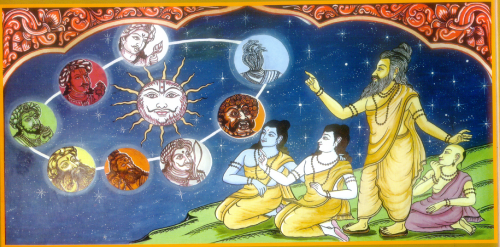Vedanga Jyotisha (वेदाङ्गज्योतिषम्)
| This article needs editing.
Add and improvise the content from reliable sources. |
Jyotisha (Samskrit : वेदाङ्गज्योतिष) is described as one of the six branches of knowledge called Shad Vedangas. Vedangas are the ancillary subjects of the Vedas and help in understanding the processes associated with the life in Vedic times. The purpose of the Jyotisha was to fix suitable times for performing different Yajnas and this involves knowledge of astronomy. Vedanga Jyotisha by Lagadha is a crucial text in giving us the picture of development of Astronomy in ancient Bharatavarsha. The text can be considered as the records of the essential astronomical knowledge needed for the day-to-day life of the people of those times. Although the text is said to belong to later date (1400 B.C.), the subject is said to be the culmination of the knowledge developed through years of observations, accumulated over thousands of years prior to 1400 B.C.
In modern common parlance, the word Jyotisha is used to mean predictive astrology (Phalita Jyotisha), however in Vedangas the word Jyotisha is associated with the science of Astronomy which includes mathematics (Ganita) also. This article primarily refers to Jyotisha as a part of Vedangas, hence the term Vedanga Jyotisha is used (which is also the name of the valuable text given by Maharshi Lagadha). Mathematics or Ganita was regarded as a part of Vedanga Jyotisha as a discipline.[1]
परिचयः || Introduction
Astronomy is the main subject of the text Vedanga Jyotisha. Even during Rigvedic times astral sciences were highly developed where people acquired knowledge of the movement of sun and moon for knowing the seasons which was important in performing yajnas such as Darsapurnamasa and Chaturmasya. Ancient people had knowledge of the calculations for eclipses, full moon (Amavasya) and new moon (Purnima) days, of nakshatras (stellar constellations) as it is required for determining the commencement of specific Yajnas.[1]
Jyotisha in Vedas
Like many branches of knowledge, the beginnings of astronomy in Bharatavarsha have been traced back to the Vedas. Vedanga Jyotisha text is found in two recensions - Rigveda Jyotisha and Yajurveda Jyotisha. Though the contents of both the recensions are the same they differ in the number of verses contained in them. Rigveda version contains only 36 verses whereas the Yajurveda version contains 44 verses, the difference attributed to the addition of explanatory verses given by the adhvaryu who used them.
यथा शिखा मयूराणां नागानां मणयो यथा । तद्वद्वेदाङ्गशास्राणां ज्योतिषं (गणितं) मूर्धनि स्थितम् ॥ १९ ॥ (Veda. Jyot. Yaju. 4)
Like the crests on the heads of peacocks, like the gems on the hoods of the snakes (cobras) astronomy (mathematics) is at the highest position of vedanga shastras (the six ancillary branches of knowledge).

